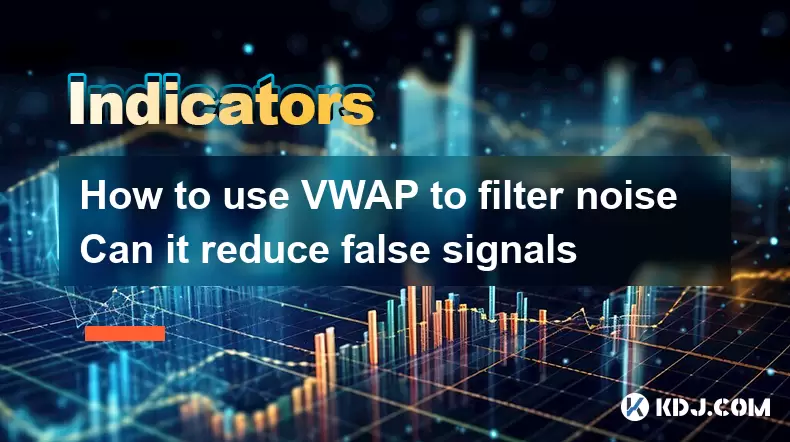-
 bitcoin
bitcoin $122090.672462 USD
1.59% -
 ethereum
ethereum $4493.758974 USD
0.56% -
 xrp
xrp $3.033145 USD
0.65% -
 tether
tether $1.000629 USD
0.00% -
 bnb
bnb $1169.854250 USD
7.07% -
 solana
solana $230.954786 USD
-0.19% -
 usd-coin
usd-coin $0.999785 USD
0.00% -
 dogecoin
dogecoin $0.256108 USD
-1.12% -
 tron
tron $0.342333 USD
-0.12% -
 cardano
cardano $0.859632 USD
-0.10% -
 hyperliquid
hyperliquid $48.932146 USD
-2.25% -
 chainlink
chainlink $22.345466 USD
-1.29% -
 ethena-usde
ethena-usde $1.000217 USD
-0.03% -
 avalanche
avalanche $31.203456 USD
1.93% -
 sui
sui $3.579145 USD
1.05%
How to use VWAP to filter noise Can it reduce false signals
VWAP helps traders filter market noise and reduce false signals in crypto trading by providing a stable price reference, aiding in better entry and exit decisions.
May 22, 2025 at 09:28 pm

The Volume Weighted Average Price (VWAP) is a popular trading indicator used by many in the cryptocurrency market to assess the average price at which a cryptocurrency has traded throughout the day, based on both volume and price. It is particularly useful for traders looking to filter out market noise and reduce false signals, which can lead to more informed trading decisions. In this article, we will explore how to effectively use VWAP to minimize noise and potentially reduce false signals in your trading strategy.
Understanding VWAP and Its Importance in Crypto Trading
VWAP is calculated by taking the total dollar value of all trading periods divided by the total trading volume for the same timeframe. In the context of cryptocurrency trading, VWAP can help traders identify the true value of an asset amidst the volatility and noise often associated with the market. By comparing the current price of a cryptocurrency to its VWAP, traders can determine if the asset is currently overvalued or undervalued, which can be crucial for making buy or sell decisions.
Using VWAP effectively requires a solid understanding of how it works and how it can be applied to different trading strategies. Traders often use VWAP as a benchmark to gauge whether their trades are executed at favorable prices, helping them to avoid buying at peaks or selling at troughs.
Setting Up VWAP on Your Trading Platform
To start using VWAP to filter noise and reduce false signals, you first need to set it up on your trading platform. Here's how you can do it on some popular platforms:
- Binance: Navigate to the trading chart of the cryptocurrency pair you are interested in. Click on the 'Indicators' button, then search for 'VWAP' and add it to your chart. You can customize the settings to fit your trading timeframe.
- TradingView: Open the chart for the cryptocurrency you want to analyze. Click on the 'Indicators' button, type 'VWAP' in the search bar, and select it. Adjust the settings as necessary to align with your trading strategy.
- Coinigy: Access the chart for your chosen cryptocurrency pair. Go to the 'Indicators' menu, find 'VWAP', and apply it to your chart. You can modify the parameters to suit your needs.
Once VWAP is set up on your chart, you can start analyzing the data to make more informed trading decisions.
Using VWAP to Identify Entry and Exit Points
One of the primary ways traders use VWAP to filter noise is by identifying potential entry and exit points. When the price of a cryptocurrency is above the VWAP line, it may indicate that the asset is overvalued, suggesting a potential sell opportunity. Conversely, if the price is below the VWAP line, it could signal that the asset is undervalued, presenting a buying opportunity.
To effectively use VWAP for this purpose, follow these steps:
- Monitor the Price Relative to VWAP: Keep an eye on how the current price of the cryptocurrency compares to the VWAP line. If the price consistently stays above or below the VWAP, it may indicate a strong trend.
- Look for Crossovers: Pay attention to moments when the price crosses the VWAP line. A crossover from below to above the VWAP can signal a bullish trend, while a crossover from above to below may indicate a bearish trend.
- Combine with Other Indicators: To further reduce false signals, consider using VWAP in conjunction with other technical indicators like Moving Averages, RSI, or MACD. This can help confirm trends and improve the accuracy of your trading signals.
Reducing False Signals with VWAP
False signals are a common challenge in cryptocurrency trading, often leading to poor decision-making and potential losses. VWAP can play a significant role in minimizing these false signals by providing a more stable reference point for price action.
Here are some strategies to reduce false signals using VWAP:
- Avoid Trading on Short-Term Fluctuations: Since VWAP is calculated over a specific period, it can help smooth out short-term price fluctuations. Focus on longer-term trends rather than reacting to every minor price movement.
- Use Multiple Timeframes: Analyze VWAP across different timeframes to get a more comprehensive view of the market. For instance, compare the hourly VWAP with the daily VWAP to confirm trends and reduce the likelihood of false signals.
- Set Clear Trading Rules: Establish strict rules for when to enter or exit a trade based on VWAP. For example, you might decide to buy only when the price is significantly below the VWAP and sell when it rises above it by a certain percentage.
Integrating VWAP with Other Trading Strategies
While VWAP can be a powerful tool on its own, its effectiveness can be enhanced when integrated with other trading strategies. Here are some ways to combine VWAP with other approaches:
- Trend Following: Use VWAP to confirm trends identified by other indicators. If a moving average suggests a bullish trend and the price is consistently above the VWAP, it strengthens the case for a buy signal.
- Mean Reversion: VWAP can help identify potential mean reversion opportunities. If the price deviates significantly from the VWAP, it may eventually revert back, providing a trading opportunity.
- Breakout Trading: Look for instances where the price breaks out from a consolidation phase and crosses the VWAP line. This can signal the start of a new trend, offering a chance to enter a trade early.
Practical Example of Using VWAP to Filter Noise
To illustrate how VWAP can be used to filter noise and reduce false signals, let's consider a practical example involving Bitcoin (BTC).
Suppose you are analyzing the hourly chart of BTC/USD on TradingView. You notice that the price has been fluctuating around the VWAP line for the past few hours. Suddenly, the price breaks above the VWAP and starts to trend upwards. To confirm this signal and reduce the chance of a false breakout, you decide to check the daily VWAP as well.
- Check the Daily VWAP: You switch to the daily timeframe and see that the price is also above the daily VWAP, confirming the bullish trend.
- Combine with RSI: You add the Relative Strength Index (RSI) to the hourly chart and see that it is not in the overbought territory, further supporting the buy signal.
- Enter the Trade: Based on the combined analysis, you decide to enter a long position on BTC/USD.
By using VWAP in conjunction with other indicators and timeframes, you have filtered out the noise and reduced the likelihood of acting on a false signal.
Frequently Asked Questions
Q: Can VWAP be used for all cryptocurrencies, or is it more effective for certain types?A: VWAP can be used for any cryptocurrency, but its effectiveness may vary depending on the liquidity and trading volume of the asset. It is generally more reliable for high-volume cryptocurrencies like Bitcoin and Ethereum, where the data is more robust and less susceptible to manipulation.
Q: How frequently should the VWAP be recalculated for optimal results?A: The frequency of VWAP recalculation depends on your trading timeframe. For day traders, recalculating VWAP every hour or every few hours can be beneficial. For swing traders, daily or even weekly VWAP might be more appropriate. The key is to align the recalculation frequency with your trading strategy.
Q: Is VWAP more useful in bullish or bearish markets?A: VWAP can be useful in both bullish and bearish markets. In a bullish market, it helps identify potential buying opportunities when the price dips below the VWAP. In a bearish market, it can signal selling opportunities when the price rises above the VWAP. The key is to use VWAP as part of a comprehensive trading strategy that adapts to different market conditions.
Q: Can VWAP be used effectively in highly volatile markets?A: Yes, VWAP can be particularly useful in highly volatile markets as it helps smooth out price fluctuations and provides a more stable reference point. However, in extremely volatile conditions, it is crucial to combine VWAP with other indicators and risk management techniques to mitigate the impact of sudden price swings.
Disclaimer:info@kdj.com
The information provided is not trading advice. kdj.com does not assume any responsibility for any investments made based on the information provided in this article. Cryptocurrencies are highly volatile and it is highly recommended that you invest with caution after thorough research!
If you believe that the content used on this website infringes your copyright, please contact us immediately (info@kdj.com) and we will delete it promptly.
- BlockDAG, DOGE, HYPE Sponsorship: Crypto Trends Shaping 2025
- 2025-10-01 00:25:13
- Deutsche Börse and Circle: A StableCoin Adoption Powerhouse in Europe
- 2025-10-01 00:25:13
- BlockDAG's Presale Buzz: Is It the Crypto to Watch in October 2025?
- 2025-10-01 00:30:13
- Bitcoin, Crypto, and IQ: When Genius Meets Digital Gold?
- 2025-10-01 00:30:13
- Stablecoins, American Innovation, and Wallet Tokens: The Next Frontier
- 2025-10-01 00:35:12
- NBU, Coins, and Crypto in Ukraine: A New Yorker's Take
- 2025-10-01 00:45:14
Related knowledge

What is a tower bottom candlestick pattern? Does it have a high success rate?
Sep 22,2025 at 07:18am
Tower Bottom Candlestick Pattern Explained1. The tower bottom candlestick pattern is a reversal formation that typically appears at the end of a downt...

What is a black hole pattern in the MACD indicator? Is it a cause for concern?
Sep 21,2025 at 06:54pm
Bitcoin's Role in Decentralized Finance1. Bitcoin remains the cornerstone of decentralized finance, serving as a benchmark for value and security acro...

How can I use the psychological line (PSY) to determine market sentiment?
Sep 17,2025 at 02:19pm
Understanding the Psychological Line (PSY) in Cryptocurrency TradingThe Psychological Line, commonly referred to as PSY, is a momentum oscillator used...

How can I determine if a double top pattern has officially formed?
Sep 21,2025 at 03:18am
Understanding the Structure of a Double Top Pattern1. A double top pattern consists of two distinct peaks that reach approximately the same price leve...

What is the Golden Valley pattern on the moving average? Is it better than the Silver Valley pattern?
Sep 21,2025 at 02:54pm
Understanding the Golden Valley Pattern in Moving Averages1. The Golden Valley pattern is a technical formation observed in cryptocurrency price chart...

What does a death cross of the RSI in the strong zone (above 50) mean?
Sep 17,2025 at 10:54pm
Understanding the Death Cross in RSI Context1. The term 'death cross' is traditionally associated with moving averages, where a short-term average cro...

What is a tower bottom candlestick pattern? Does it have a high success rate?
Sep 22,2025 at 07:18am
Tower Bottom Candlestick Pattern Explained1. The tower bottom candlestick pattern is a reversal formation that typically appears at the end of a downt...

What is a black hole pattern in the MACD indicator? Is it a cause for concern?
Sep 21,2025 at 06:54pm
Bitcoin's Role in Decentralized Finance1. Bitcoin remains the cornerstone of decentralized finance, serving as a benchmark for value and security acro...

How can I use the psychological line (PSY) to determine market sentiment?
Sep 17,2025 at 02:19pm
Understanding the Psychological Line (PSY) in Cryptocurrency TradingThe Psychological Line, commonly referred to as PSY, is a momentum oscillator used...

How can I determine if a double top pattern has officially formed?
Sep 21,2025 at 03:18am
Understanding the Structure of a Double Top Pattern1. A double top pattern consists of two distinct peaks that reach approximately the same price leve...

What is the Golden Valley pattern on the moving average? Is it better than the Silver Valley pattern?
Sep 21,2025 at 02:54pm
Understanding the Golden Valley Pattern in Moving Averages1. The Golden Valley pattern is a technical formation observed in cryptocurrency price chart...

What does a death cross of the RSI in the strong zone (above 50) mean?
Sep 17,2025 at 10:54pm
Understanding the Death Cross in RSI Context1. The term 'death cross' is traditionally associated with moving averages, where a short-term average cro...
See all articles










































































